Battery Energy Storage Systems in Ships’ Hybrid/Electric Propulsion Systems
Abstract
1. Introduction
- Use of BESS as an alternative to conventional diesel propulsion: BESS allows green electricity generated onshore to be used instead of conventional fossil fuels. Not all the vessels can benefit from this solution but using BESS will substantially reduce emissions and energy costs. There are countries where electrical energy is cheaper than the electricity generated on board the ships in a conventional way. Moreover, electricity is generated by renewable power sources that make such propulsion 100% green.
- Batteries can be utilized for optimization of diesel generator loading: This feature allows higher efficiency and lower emissions of the engines.
- Spinning reserve: This mainly applies to diesel electric dynamic positioning vessels. Using a battery-provided spinning reserve allows the vessel to reduce the number of generators running required to maintain the spinning reserve. It allows for lower fuel consumption, lower emissions, higher efficiency of running engines and lower maintenance costs due to reduced running hours.
- Compensating load peaks: Battery energy storage systems also provide additional electric power required for short-term additional power demands. In conventional propulsion systems, it is necessary to run additional diesel generator to meet those demands. Using a battery instead, the additional generator can be turned off, therefore saving on fuel and wear and tear of the engine. Vessels equipped with heavy electricity consumers such as cranes or electric-driven thrusters will benefit from this arrangement. It is also possible to recover the braking energy from large consumers such as, e.g., heavy duty cranes.
- Back-up power: BESS allows the vessel to stop diesel engines when onboard electricity consumption is low (e.g., in port). The generators are started only to charge the batteries. It is possible to reduce emissions because the diesel engines operate at optimal load (with maximum efficiency and minimum specific fuel consumption) during charging.
- Shore-to-ship power connection for ships in port, which allow ships to switch off their diesel generators when moored up, reducing noise and emissions.
- Gas engines and other energy sources are not capable of handling fast load variations. In such cases, a BESS can be utilized to take care of the variations, while the main energy source produces slowly varying power [6].
2. Literature Review
- Interface between PMS and BMS;
- Blackout recovery of the propulsion/power generation system;
- Control of the hybrid drive;
- Flow energy control to and from the batteries;
- To control connecting the consumers to the grid;
- Monitoring of the critical parameters of the propulsion/power generation system.
3. Review of the Marine Battery Energy Storage Systems Installed on Hybrid-Electric Propulsion Ships
3.1. Hybrid-Electric Propulsion in the Offshore Industry
- Fuel consumption was reduced by 10–15%;
- NOX emissions were reduced by 25%;
- GHG emissions were reduced by 30%;
- Maintenance costs were reduced due via:
- −
- Substantial decrease in engine running hours;
- −
- Minimized low load running;
- −
- Extended intervals between major overhauls;
- −
- Limited unplanned maintenance.
- Improved machinery performance, utilization and flexibility.
3.2. Electric Propulsion Ferries
3.3. High Speed Ferries/High Speed Vessels
3.4. Hybrid Harbour Tugs
- Diesel–Mechanic—either fixed pitch (FPP) or controllable pitch (CPP) propellors, high- or medium-speed engines: This is a conventional tug propulsion with two diesel main engines directly driving the propellers. This propulsion system is used as a basis for comparison purposes.
- Diesel–Mechanic—either FPP or CPP with power take-in (PTI): In addition to the direct-drive diesel engines, the system is equipped with a PTI (power take-in). The electric motors are powered by the auxiliary generator.
- Diesel–Mechanic hybrid configuration—either FPP or CPP with power take-in/power take-out and a battery: In this setup, the propulsion is supported by a BESS. The genset can operate at variable rpm. The batteries can be charged by the PTOs, the diesel driven generator or from an onshore charging connection. Figure 10 shows the single-line diagram of the diesel–mechanic hybrid system.There are different modes of operation in a diesel–mechanic hybrid configuration:
- Electric mode: Both engines are stopped, and all consumers are supplied from the batteries. Propulsion is run using PTI. Maximum propulsion power is 920 kW (max 21 min with 600 kWh battery capacity), 10 knots eco-speed.
- Hybrid/electric mode: The diesel engines’ start/stop control depends on the charge of the battery. The engines provide power and recharge the batteries when they are at low charge.
- Hybrid mode: One of the diesel engines supplies the PTO and runs the propeller. The other thruster is powered by the PTI. Batteries support propulsion during peak shaving and required power boosts. Maximum speed is 10 knots.
- Power boost mode: The diesel engines and PTI provide power simultaneously. Maximum continuous propulsion: 3420 kW; maximum peak propulsion: 4350 kW with battery support for a maximum of 22 min.
- Diesel–electric—with FPP: This configuration features a diesel–electric version with variable speed of the main engines and direct current grid distribution. It is separated into two independent propulsion subsystems.
- Diesel–electric hybrid configuration—FPP with a battery. Same configuration as diesel electric but has less power installed due to the reduced number of the engines’ cylinders and one generator set replaced by BESS. Figure 11 shows the single-line diagram of the diesel–electric hybrid system.There are four different modes of operation in diesel–electric hybrid configuration:
- Electric mode: Both engines are stopped, and all consumers are supplied from the batteries. Maximum propulsion power is 1400 kW, 10 knots eco-speed, 29 min operating time on batteries.
- Hybrid/electric mode: The diesel engines’ start/stop control depends on the charge of the battery. Engines provide power and recharge the batteries when they are at low charge.
- One-generator mode: One of the diesel engines supplies the power. The batteries take the boost from sudden load peaks. Maximum continuous propulsion: 1400 kW. Batteries provide boosts for the propellers of up to 2920 kW for 14 min.
- Two-generator mode (power boost): The batteries and diesel generators provide power together. Batteries support the propulsion during peak shaving and required power boosts. Maximum continuous propulsion: 2940 kW; maximum peak propulsion: 4150 kW with battery support for a maximum of 17 min.
3.5. Fully Electric Autonomous Ships
3.6. Hybrid Electric Passenger Vessels
3.7. BESS on Fishing Vessels
3.8. Green Coastal Shipping Program
- NorLines’ future cargo ferry with LNG/battery hybrid propulsion and zero-emission port sailing and port operation, including electric cranes with energy recovery.
- The second pilot involved Teekay’s next-generation low emission shuttle tanker. The goal of the second pilot was to investigate the possibility of using alternative fuels (LNG and/or VOC) combined with redundant power generation for offshore dynamic positioning operations. Another goal of this program was to evaluate the potential use of BESS and of a hybrid solution.
- The third pilot program involves an electric-hybrid aquaculture vessel specified by the Cargo Freighters’ Association and ABB.
- Similarly, the Norwegian Gas Association and Øytank Bunkersservice are exploring the benefits of hybridizing a bulk vessel that is planned to be converted to a low-cost LNG bunker vessel with gas propulsion.
- The fifth pilot program was initiated by the Port of Risavika, which plans to electrify its port operations, including heavy-duty vehicles and crane operations, and to offer cold ironing services. Part of the plan is also to offer to charge ships with plug-in hybrid solutions.
3.9. Deep-Sea Vessels
4. Conclusions
Author Contributions
Funding
Institutional Review Board Statement
Data Availability Statement
Conflicts of Interest
References
- DNV GL Handbook for Maritime and Offshore Battery Systems, Report No.: 2016-1056. Available online: https://www.dnv.com/maritime/publications/maritime-and-offshore-battery-systems-download.html (accessed on 12 November 2022).
- International Maritime Organization—Marine Environment Protection Committee (MEPC 76), 10 to 17 June 2021 Session. Available online: https://www.dnv.com/news/imo-update-marine-environment-protection-committee-mepc-76-203128 (accessed on 12 November 2022).
- IMO RESOLUTION MEPC.347(78) Adopted on 10 June 2022. Available online: https://www.ccs.org.cn/ccswzen//articleDetail?id=202212210544869589 (accessed on 12 November 2022).
- DNV Maritime Forecast to 2050—Energy Transition Outlook 2022. Available online: https://www.dnv.com/maritime/publications/maritime-forecast-2022/index.html (accessed on 12 November 2022).
- Electric and Hybrid Marine Power Systems. Available online: https://www.sintef.no/en/expertise/sintef-energy-research/electric-and-hybrid-marine-power-systems/ (accessed on 12 November 2022).
- Bø, T.A.; Vaktskjold, E.; Pedersen, E.; Mo, O. Model Predictive Control of Marine Power Plants with Gas Engines and Battery. Inst. Electr. Electron. Eng. 2019, 7, 15706–15721. [Google Scholar] [CrossRef]
- Kersey, J.; Popovich, N.D.; Phadke, A.A. Rapid battery cost declines accelerate the prospects of all-electric interregional container shipping. Nat. Energy 2022, 7, 664–674. [Google Scholar] [CrossRef]
- Mongird, K.; Viswanathan, V.; Alam, J.; Vartanian, C.; Sprenkle, V.; Baxter, R. Energy Storage Grand Challenge Cost and Performance Assessment 2020. Available online: https://www.pnnl.gov/sites/default/files/media/file/Final%20-%20ESGC%20Cost%20Performance%20Report%2012-11-2020.pdf (accessed on 25 December 2022).
- Zhou, Z.; Benbouzid, M.; Charpentier, J.F.; Scuiller, F.; Tang, T. A review of energy storage technologies for marine current energy systems. Renew. Sustain. Energy Rev. 2013, 18, 390–400. [Google Scholar] [CrossRef]
- European Maritime Safety Agency. Study on Electrical Energy Storage for Ships by DNV GL; Report No.: 2019-0217, Rev. 04. Document No.: 11B59ZDK-1. Date: 2020-05-05.; EMSA European Maritime Safety Agency: Lisbon, Portugal, 2020. [Google Scholar]
- Vicenzutti, A.; Sulligoi, G. Electrical and Energy Systems Integration for Maritime Environment-Friendly Transportation. Energies 2021, 14, 7240. [Google Scholar] [CrossRef]
- Mutarraf, M.U.; Terriche, Y.; Niazi, K.A.K.; Vasquez, J.C.; Guerrero, J.M. Energy Storage Systems for Shipboard Microgrids—A Review. Energies 2018, 11, 3492. [Google Scholar] [CrossRef]
- Thangalakshmi, P.; Ganeshram, V. Energy Storage Systems—Possible Impacts on Maritime Sector. IJIREEICE 2022, 10, 1–9. [Google Scholar] [CrossRef]
- Karkosiński, D.; Rosiński, W.A.; Deinrych, P.; Potrykus, S. Onboard Energy Storage and Power Management Systems for All-Electric Cargo Vessel Concept. Energies 2021, 14, 1048. [Google Scholar] [CrossRef]
- Verma, J.; Kumara, D. Recent developments in energy storage systems for marine environment. Mater. Adv. 2021, 2, 6800–6815. [Google Scholar] [CrossRef]
- He, W.; Mo, O.; Remøy, A.; Valøen, L.O.; Såtendal, H.; Howie, A.; Vie, P.J.S. Accelerating Efficient Installation and Optimization of Battery Energy Storage System Operations Onboard Vessels. Energies 2022, 15, 4908. [Google Scholar] [CrossRef]
- Yi-Kuan, K. Application of Lithium-Ion Batteries in Energy Storage Systems. J. Mar. Sci. Technol. 2019, 27, 3. [Google Scholar] [CrossRef]
- Xianqiang, B.; Xinghua, X.; Zhang, Y.; Xiong, Y.; Shang, C. Optimal Sizing of Battery Energy Storage System in a Shipboard Power System with considering Energy Management Optimization. Hindawi 2021, 2021. [Google Scholar] [CrossRef]
- Barrera-Cárdenas, R.A.; Mo, O.; Guidi, G. Optimal Sizing of Battery Energy Storage Systems for Hybrid Marine Power Systems. In Proceedings of the 2019 IEEE Electric Ship Technologies Symposium—ESTS, Washington, DC, USA, 14–16 August 2019; pp. 293–302. [Google Scholar] [CrossRef]
- Mo, O.; Guidi, G. Design of Minimum Fuel Consumption Energy Management Strategy for Hybrid Marine Vessels with Multiple Diesel Engine Generators and Energy Storage. In Proceedings of the 2018 IEEE Transportation Electrification Conference and Expo—ITEC, Long Beach, CA, USA, 13–15 June 2018. [Google Scholar]
- Rong, C.; Wanneng, Y.; Yonghuai, Z.; Jinduo, W. Energy management strategy of marine lithium batteries based on cyclic life. IOP Conf. Ser. Earth Environ. Sci. 2020, 467, 012204. [Google Scholar] [CrossRef]
- Rashkin, L.J.; Neely, J.C.; Wilson, D.G.; Glover, S.F.; Doerry, N.; Markle, S.; McCoy, T.J. Energy storage design considerations for an MVDC power system. J. Mar. Eng. Technol. 2020, 19 (Suppl. S1), 92–103. [Google Scholar] [CrossRef]
- Fang, S.; Wang, H. Optimization-Based Energy Management for Multi-Energy Maritime Grids; Naval Architecture, Marine Engineering, Shipbuilding and Shipping; Springer Nature Singapore Pte Ltd.: Singapore, 2021; p. 11. ISSN 2194-8445. [Google Scholar] [CrossRef]
- Jeevarajan, J.A.; Joshi, T.; Parhizi, M.; Rauhala, T.; Juarez-Robles, D. Battery Hazards for Large Energy Storage Systems. ACS Energy Lett. 2022, 7, 2725–2733. [Google Scholar] [CrossRef]
- Technical Reference for Li-ion Battery Explosion Risk and Fire Suppression, DNV Report No. Report No.: 2019-1025. Available online: https://www.dnv.com/Publications/technical-reference-for-li-ion-battery-explosion-risk-and-fire-suppression-165062 (accessed on 12 November 2022).
- DNV GL Report no 2019-1025, Technical Reference for Li-ion Battery Explosion Risk and Fire Suppression, Document No.: 1144K9G7-12, Date: 2019-11-01. Available online: https://www.dnv.com/Publications/technical-reference-for-li-ion-battery-explosion-risk-and-fire-suppression-165062 (accessed on 12 November 2022).
- The Future of Batteries in the Marine Sector: What Lies Beyond the Horizon? Available online: https://www.southampton.ac.uk/ (accessed on 12 November 2022).
- Guidelines for the Approval of Alternatives and Equivalents as Provided for in various IMO Instruments, MSC.1/Circ.1455, 24 June 2013. Available online: https://iacs.org.uk/download/8835 (accessed on 12 November 2022).
- DNV Rules for Ships—July 2022 Edition. Available online: https://www.dnv.com/news/dnv-rules-for-ships-july-2022-edition-227477 (accessed on 12 November 2022).
- DNV GL Publication in Focus –The Future Is Hybrid—A Guide to Use of Batteries in Shipping. Available online: https://www.dnv.com/maritime/publications/future-is-hybrid-download.html (accessed on 12 November 2022).
- DNV GL Report: Considerations for ESS Fire Safety, Project No.: PP151894. 2017. Available online: https://www.dnv.com/cases/considerations-for-battery-storage-safety-in-new-york-89392 (accessed on 12 November 2022).
- DNV, Batteries As Power Sources in DP Systems Power and Design. Dynamic Positioning Conference 2018. Available online: https://dynamic-positioning.com/proceedings/dp2018 (accessed on 12 November 2022).
- DNV Report Risk Handling of Lithium-Ion Batteries. 2019. Available online: https://www.sintef.no/globalassets/project/hfc/documents/6-risk-handling-of-lithium-ion-batteries-hfc.pdf (accessed on 12 November 2022).
- ABS Guide for Hybrid Electric Power Systems for Marine and Offshore Applications 2022. Available online: https://ww2.eagle.org/content/dam/eagle/rules-and-guides/current/conventional_ocean_service/319_gn_hybrid_electric_powers_systems_marine_offshore_2022/hybrid-electric-power-systems-guide-feb22.pdf (accessed on 12 November 2022).
- Schmitt, J.; Schindler, M.; Oberbauer, A.; Jossen, A. Determination of degradation modes of lithium-ion batteries considering aging-induced changes in the half-cell open-circuit potential curve of silicon–graphite. J. Power Sources 2022, 532, 231296. [Google Scholar] [CrossRef]
- DNV Report on Life Cycle Assessment of Batteries in Maritime Sector, Maritime Battery Forum c/o DNV GL, 30.09.2016. Available online: https://www.nho.no/siteassets/nox-fondet/rapporter/2018/life-cycle-analysis-for-batteries-in-maritime-sector_final_v_0.1.pdf (accessed on 12 November 2022).
- Lehmusto, M.; Santasalo-Aarnio, A. Mathematical framework for total cost of ownership analysis of marine electrical energy storage inspired by circular economy. J. Power Sources 2022, 528, 231164. [Google Scholar] [CrossRef]
- Anwar, S.; Zia, M.Y.I.; Rashid, M.; Rubens, G.Z.d.; Enevoldsen, P. Towards Ferry Electrification in the Maritime Sector. Energies 2020, 13, 6506. [Google Scholar] [CrossRef]
- Electric Ferries in the Baltic Sea Region Compendium. Available online: https://www.bsr-electric.eu/use-cases/e-ferries (accessed on 12 November 2022).
- Hybrid Power Systems for Offshore Drilling Industry. Available online: https://www.wartsila.com/insights/article/why-hybrid-power-systems-make-sense-for-the-offshore-drilling-industry (accessed on 12 November 2022).
- Viking Lady. Available online: https://corvusenergy.com/projects/viking-lady/ (accessed on 12 November 2022).
- Viking Lady. Available online: https://www.wartsila.com/marine/customer-segments/references/offshore/viking-lady (accessed on 12 November 2022).
- ENERGY CONTROL. Available online: https://www.kongsberg.com/no/maritime/products/electrical-power-system/energy-solutions/energy-control/ (accessed on 12 November 2022).
- Hybrid Dredger. Available online: https://www.wartsila.com/media/news/27-05-2019-wartsila-hy-for-dredger-enhances-dredging-efficiency-and-sustainability-2455283 (accessed on 12 November 2022).
- Hybrid Dredger. Available online: https://www.ship-technology.com/news/wartsila-dredging-operations/ (accessed on 12 November 2022).
- Hybrid Propulsion Shuttle Tanker. Available online: https://www.brunvoll.no/ship-segments/shuttle-tank (accessed on 12 November 2022).
- Hybrid Propulsion Shuttle Tanker. Available online: https://www.wartsila.com/insights/article/the-new-shuttle-tanker (accessed on 12 November 2022).
- Hybrid Propulsion Shuttle Tanker. Available online: https://www.theexplorer.no/solutions/teekay--shuttle-tankers-use-their-own-emissions-as-fuel/ (accessed on 12 November 2022).
- Aurora Spirit. Available online: https://www.ship-technology.com/projects/aurora-spirit-e-shuttle-tanker/ (accessed on 12 November 2022).
- MF Ampere. Available online: https://corvusenergy.com/projects/mf-ampere/ (accessed on 12 November 2022).
- MF Ampere. Available online: https://corvusenergy.com/an-ocean-of-opportunities/ (accessed on 12 November 2022).
- Hybrid Propulsion Ferries. Available online: https://www.forseaferries.com/ (accessed on 12 November 2022).
- Hybrid Propulsion Ferries. Available online: https://www.offshore-energy.biz/scandlines-keel-laid-for-first-zero-emission-ferry/ (accessed on 12 November 2022).
- Color Hybrid. Available online: https://www.ship-technology.com/projects/color-hybrid-ferry/ (accessed on 12 November 2022).
- Color Hybrid. Available online: https://www.colorline.com/about-us/worlds-largest-plug-in-hybrid-ship (accessed on 12 November 2022).
- Electric ferry Ellen. Available online: https://www.ship-technology.com/news/ellen-electric-ferry-denmark/ (accessed on 12 November 2022).
- Electric Ferries. Available online: http://www.conf.eferry.eu/ (accessed on 12 November 2022).
- Hybrid RO-RO Ships. Available online: https://www.offshore-energy.biz/grimaldi-welcomes-twelfth-gg5g-hybrid-roro-ship/ (accessed on 12 November 2022).
- Hybrid RO-RO Ships. Available online: https://www.electrichybridmarinetechnology.com/news/environmental/man-energy-solutions-to-provide-hybrid-propulsion-for-cldn-ro-ro-vessels.html (accessed on 12 November 2022).
- Hybrid High Speed Vessels. Available online: https://www.brunvoll.no/ship-segments/hsv-hybrid (accessed on 12 November 2022).
- Hybrid High Speed Ferries. Available online: https://corvusenergy.com/battery-powered-fast-ferry-ms-medstraum-named-ship-of-the-year/ (accessed on 12 November 2022).
- Hybrid High Speed Vessels. Available online: https://www.offshore-energy.biz/uber-boat-building-uks-1st-hybrid-high-speed-passenger-ferry/ (accessed on 12 November 2022).
- Hybrid High Speed Vessels. Available online: https://www.danfoss.com/en/about-danfoss/news/dps/danfoss-power-solutions-editron-division-to-power-the-uk-s-first-high-speed-hybrid-passenger-ferries/ (accessed on 12 November 2022).
- Hybrid Tugs. Available online: https://www.man-es.com/marine/products/hybrid-propulsion-for-tugs (accessed on 12 November 2022).
- Nishio, T.; Kifune, H. A Study on Fuel Saving Effect in Hybrid Propulsion System for Tugboat. In Proceedings of the AMEC 2016 + 7th PAAMES—Green and Sustainable Development in Shipping and Engineering, Hong Kong, China, 13–14 October 2016. [Google Scholar]
- Kutz, R. Design challenges of an innovative pusher-tug with a hybrid power unit. In Proceedings of the Electric & Hybrid Marine World Expo Conference, Fort Lauderdale, FL, USA, 11–13 January 2016. [Google Scholar] [CrossRef]
- The ABB ETG (Electric Tug). Electric and Hybrid Tug—Analysis, April 2022. Available online: https://library.e.abb.com/ (accessed on 12 November 2022).
- Hybrid Tugs. Available online: https://www.kotug.com/fleet/ (accessed on 12 November 2022).
- Hybrid Tugs. Available online: https://www.emobility-engineering.com/ekotug-rotortug-powertrain/ (accessed on 12 November 2022).
- Wärtsilä Marine Solutions Business White Paper—Wärtsilä HY Tug Propulsion Systems. Available online: https://www.wartsila.com/insights/business-areas/marine-power/white-papers (accessed on 12 November 2022).
- Hybrid Tugs. Available online: https://www.wartsila.com/docs/default-source/product-files/sd/tugs/w%C3%A4rtsil%C3%A4-hy-tug-series/wartsila-hytug-external-presentation-sept-2017.pdf?sfvrsn=236e6644_8 (accessed on 12 November 2022).
- Yara Birkeland. Available online: https://www.offshore-energy.biz/yara-birkeland-worlds-1st-fully-electric-boxship-prepares-for-commercial-ops/ (accessed on 12 November 2022).
- Yara Birkeland. Available online: https://www.kongsberg.com/maritime/support/themes/autonomous-ship-project-key-facts-about-yara-birkeland/ (accessed on 12 November 2022).
- Yara Birkeland. Available online: https://www.yara.com/knowledge-grows/game-changer-for-the-environment/ (accessed on 12 November 2022).
- Roald Amundsen. Available online: https://www.ship-technology.com/projects/ms-roald-amundsen-polar-cruise-ship/ (accessed on 12 November 2022).
- F/V Karoline. Available online: https://corvusenergy.com/projects/karoline-2/ (accessed on 12 November 2022).
- Electric Fishing Vessel. Available online: https://maritimecleantech.no/project/first-electric-fishing-vessel/ (accessed on 12 November 2022).
- Electric Fishing Vessel. Available online: https://www.theexplorer.no/solutions/selfa-arctic--the-worlds-first-hybrid-fishing-boat/ (accessed on 12 November 2022).
- Hybrid Trawler. Available online: https://ulstein.com/news/bluewild-contracts-new-factory-trawler-with-design-from-ulstein (accessed on 12 November 2022).
- Electric Fishing Vessel. Available online: https://ulstein.com/news/hybrid-propulsion-system-can-give-a-boost-for-future-emission-reduction-in-the-fishing-fleet (accessed on 12 November 2022).
- Green Shipping Program. Available online: https://greenshippingprogramme.com/ (accessed on 12 November 2022).
- Hybrid Short Sea Vessels. Available online: https://www.wartsila.com/insights/article/decarbonisation-drives-innovation-in-short-sea-shipping (accessed on 12 November 2022).
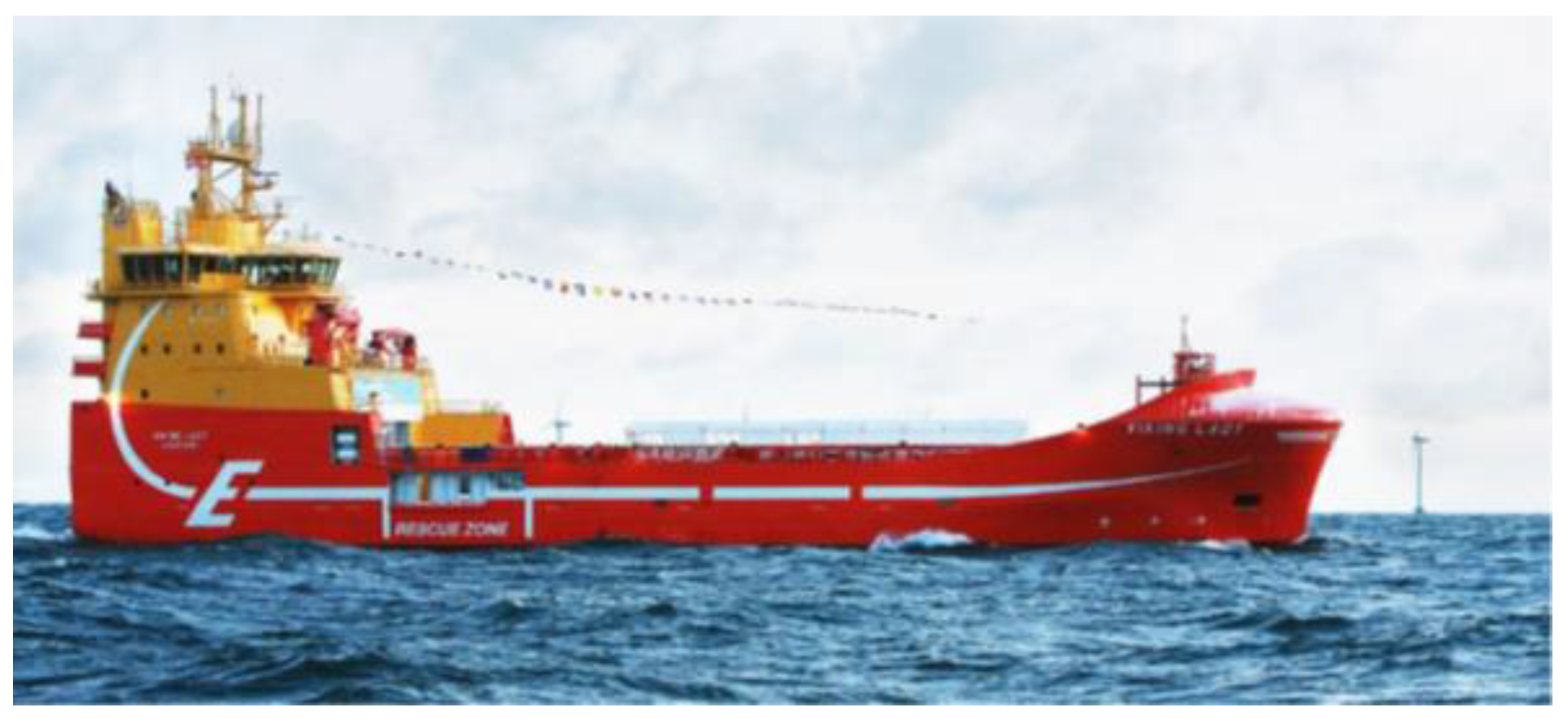
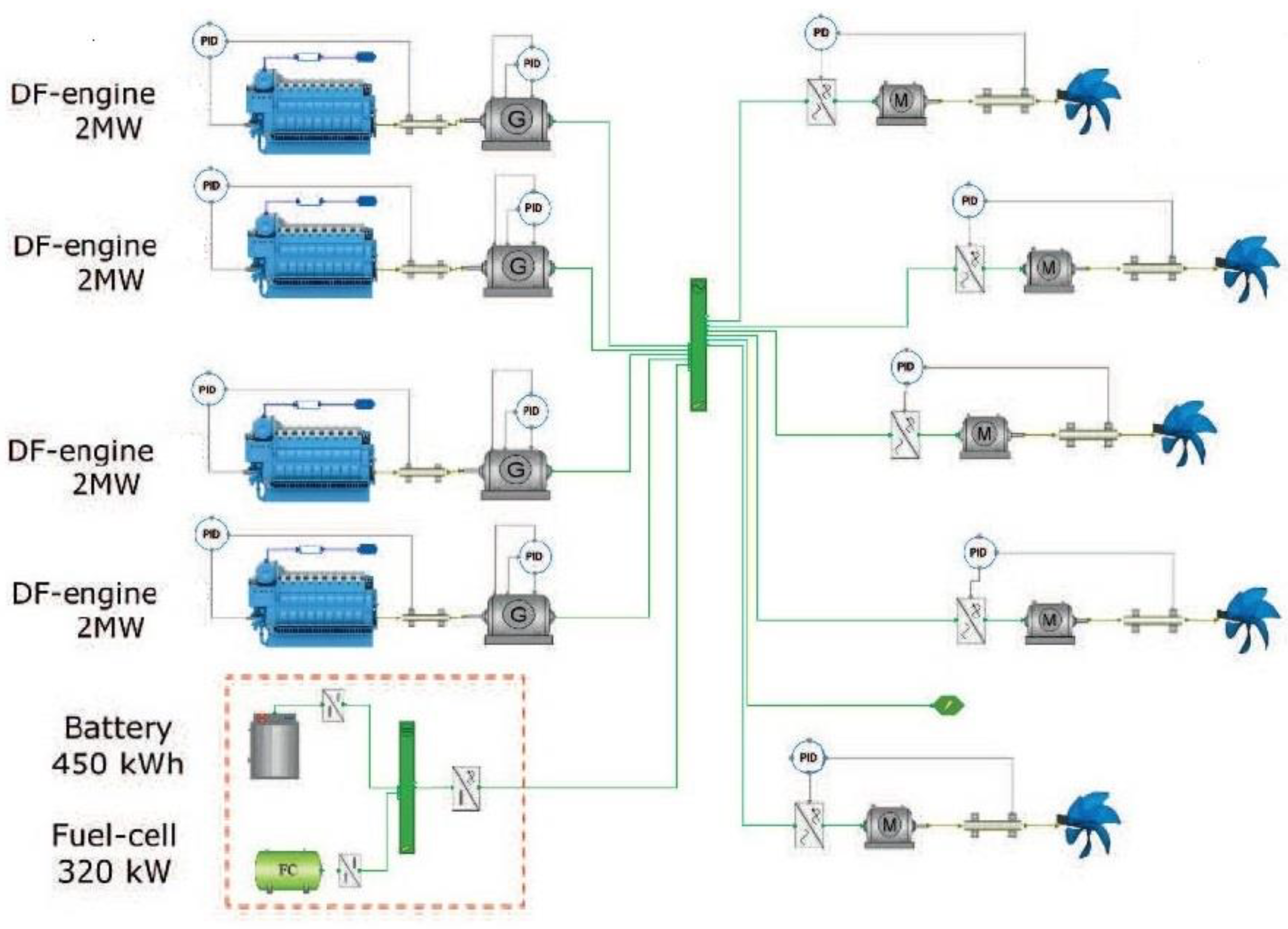
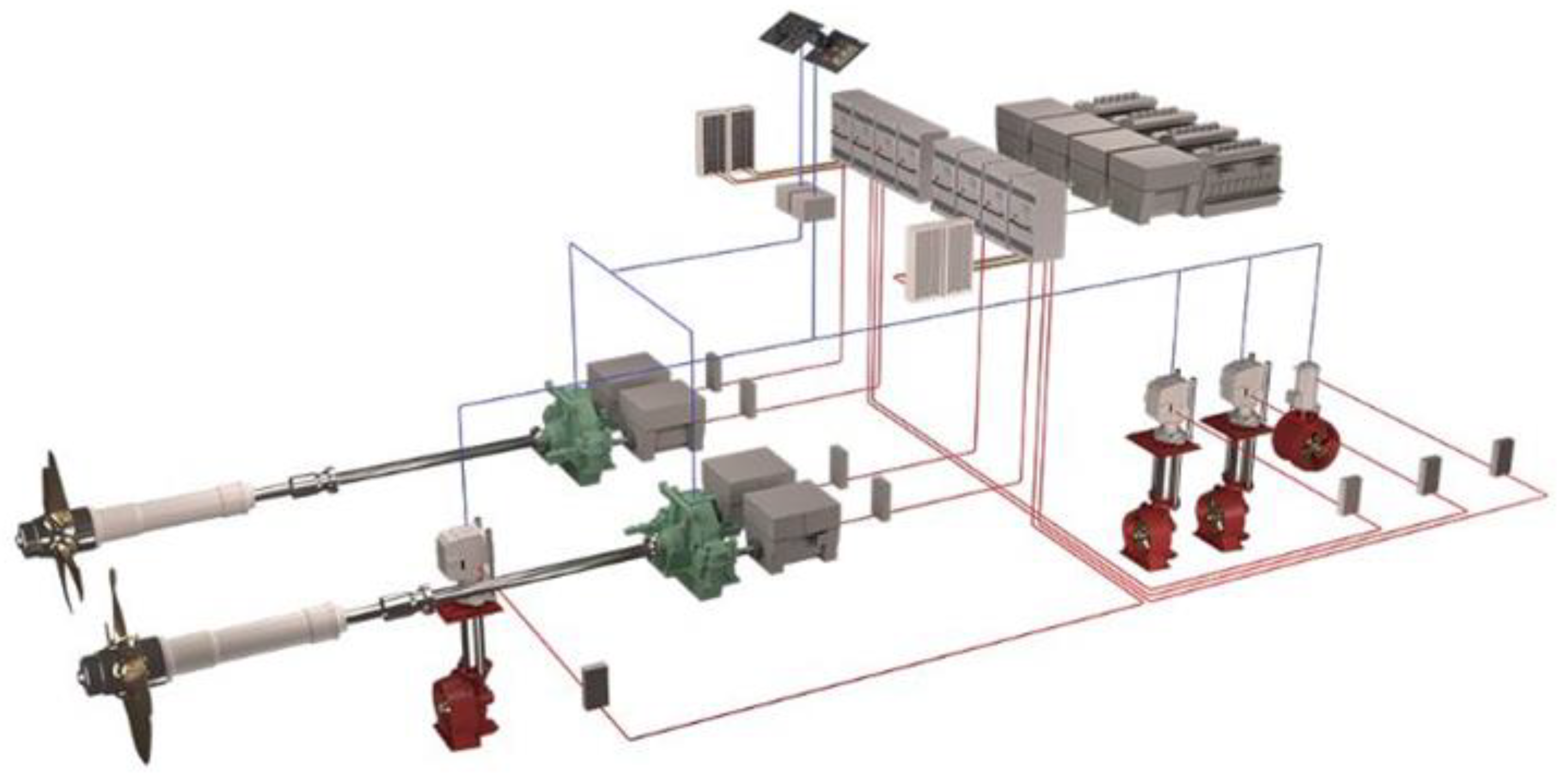
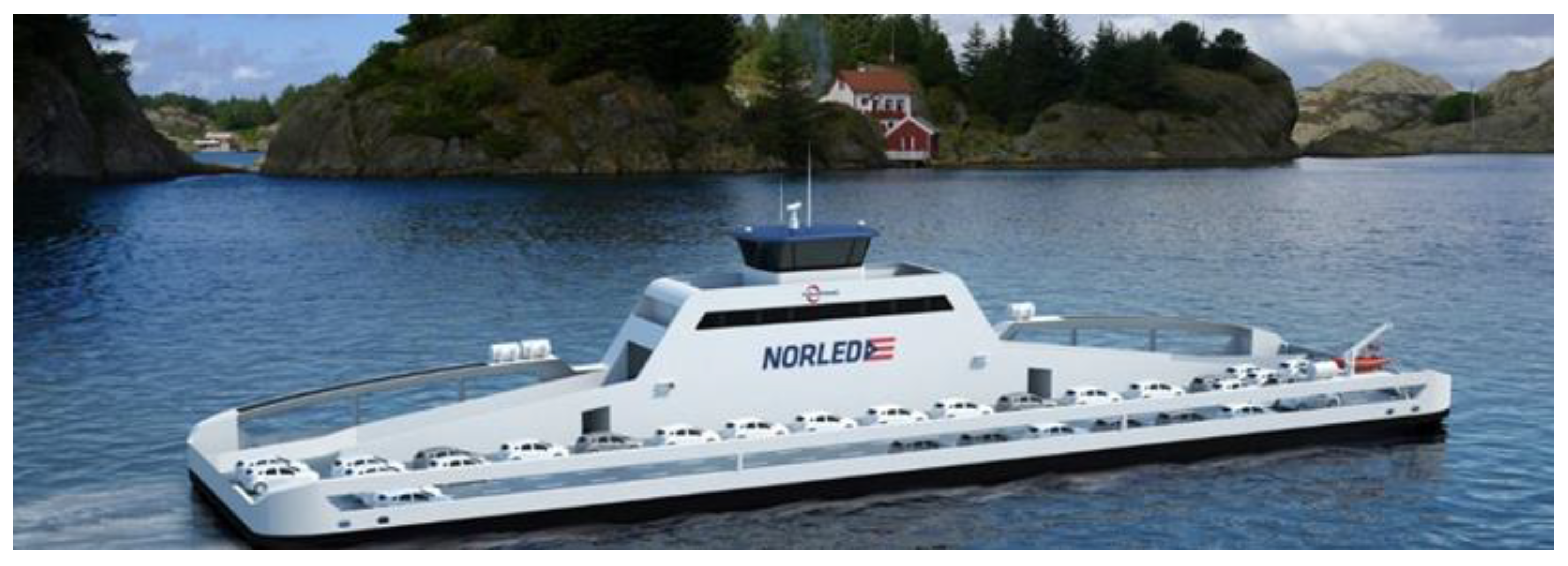
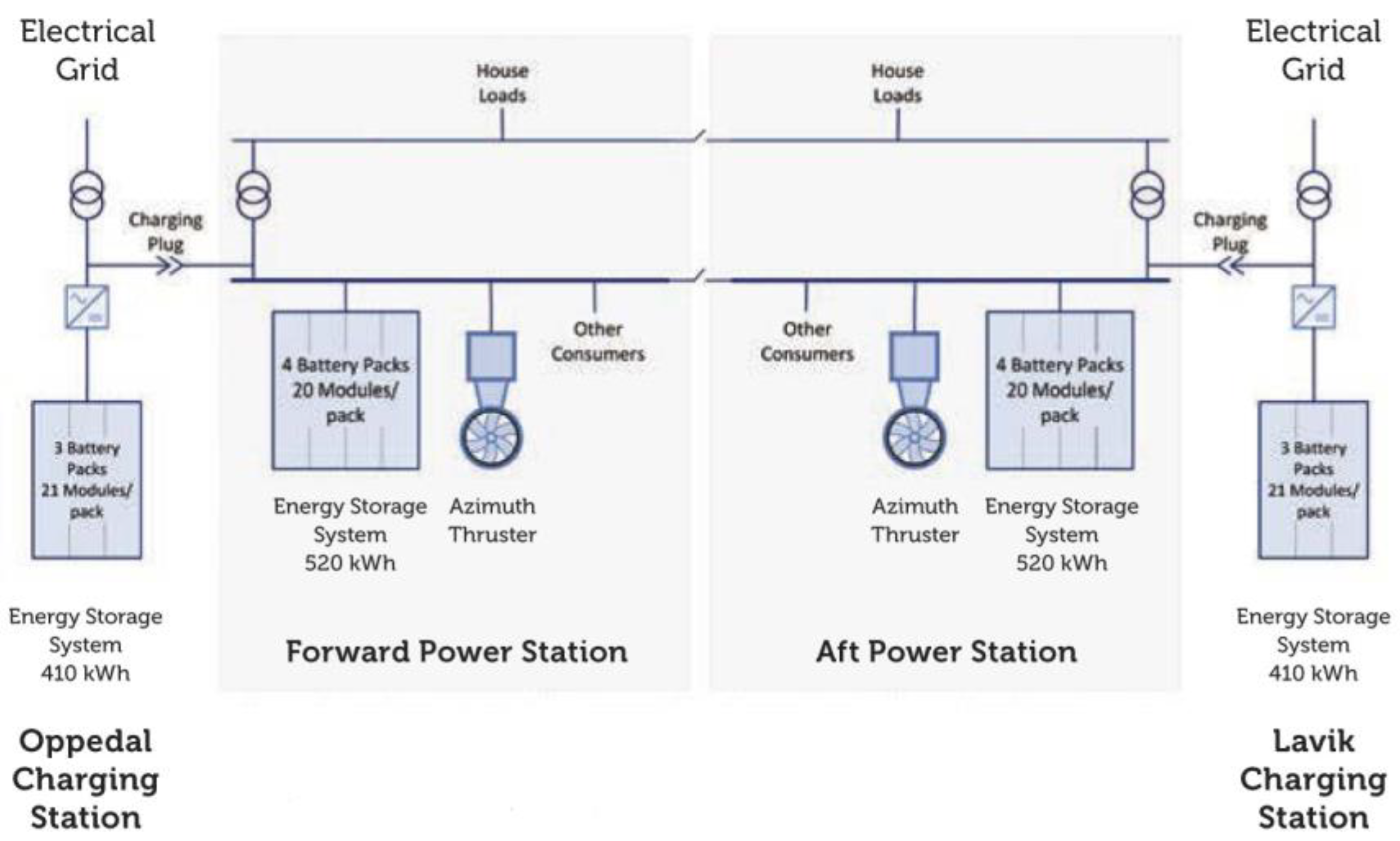

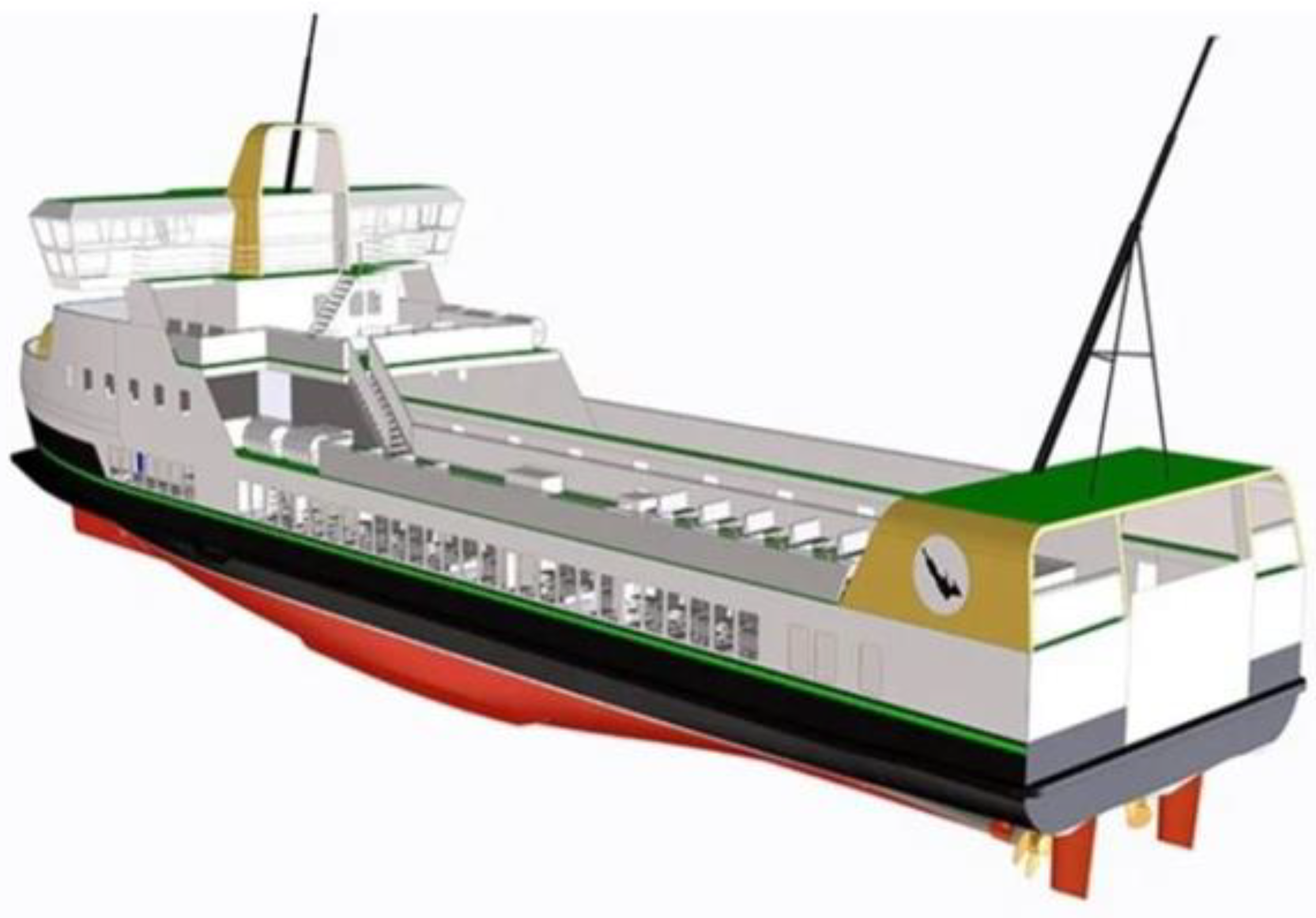
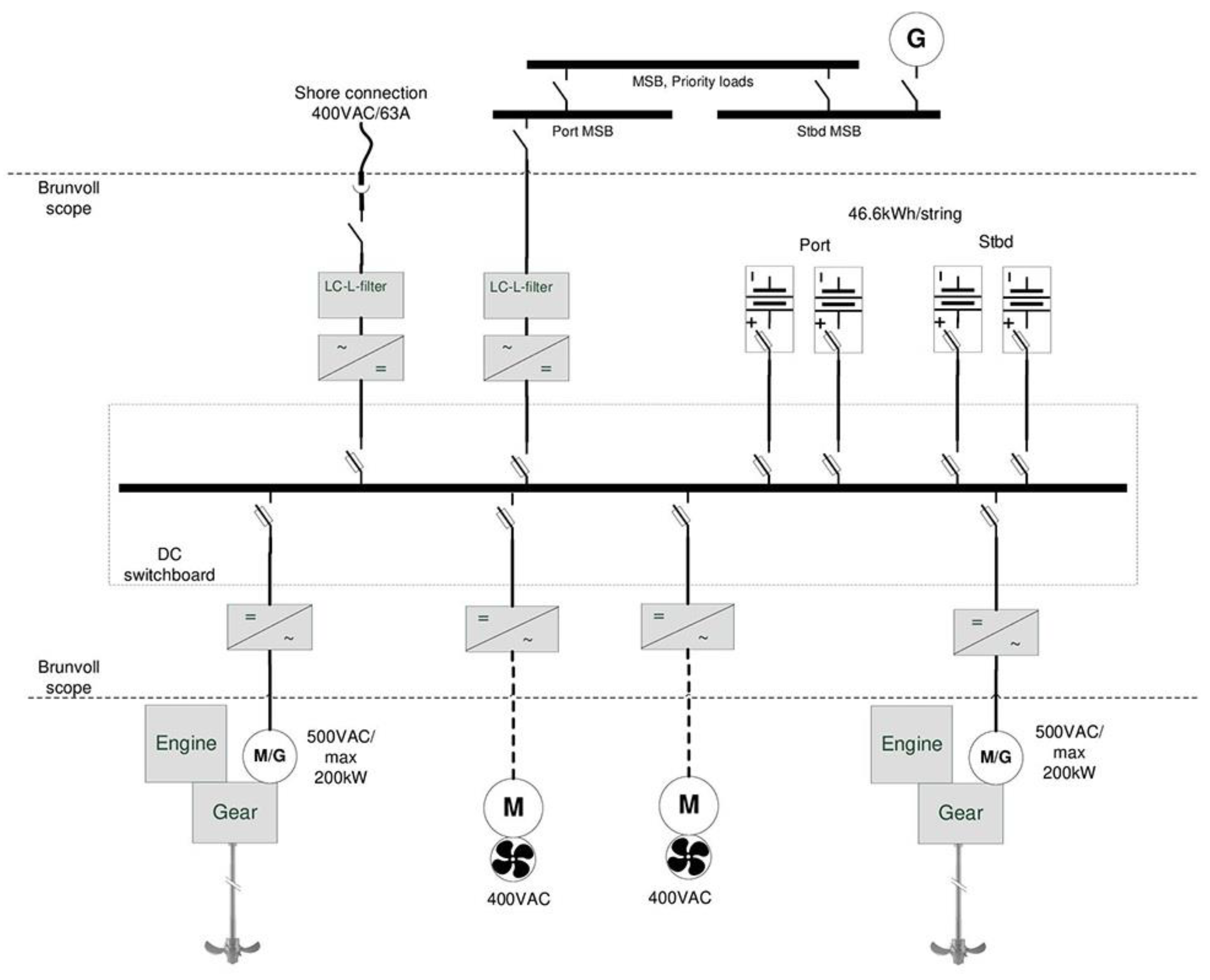

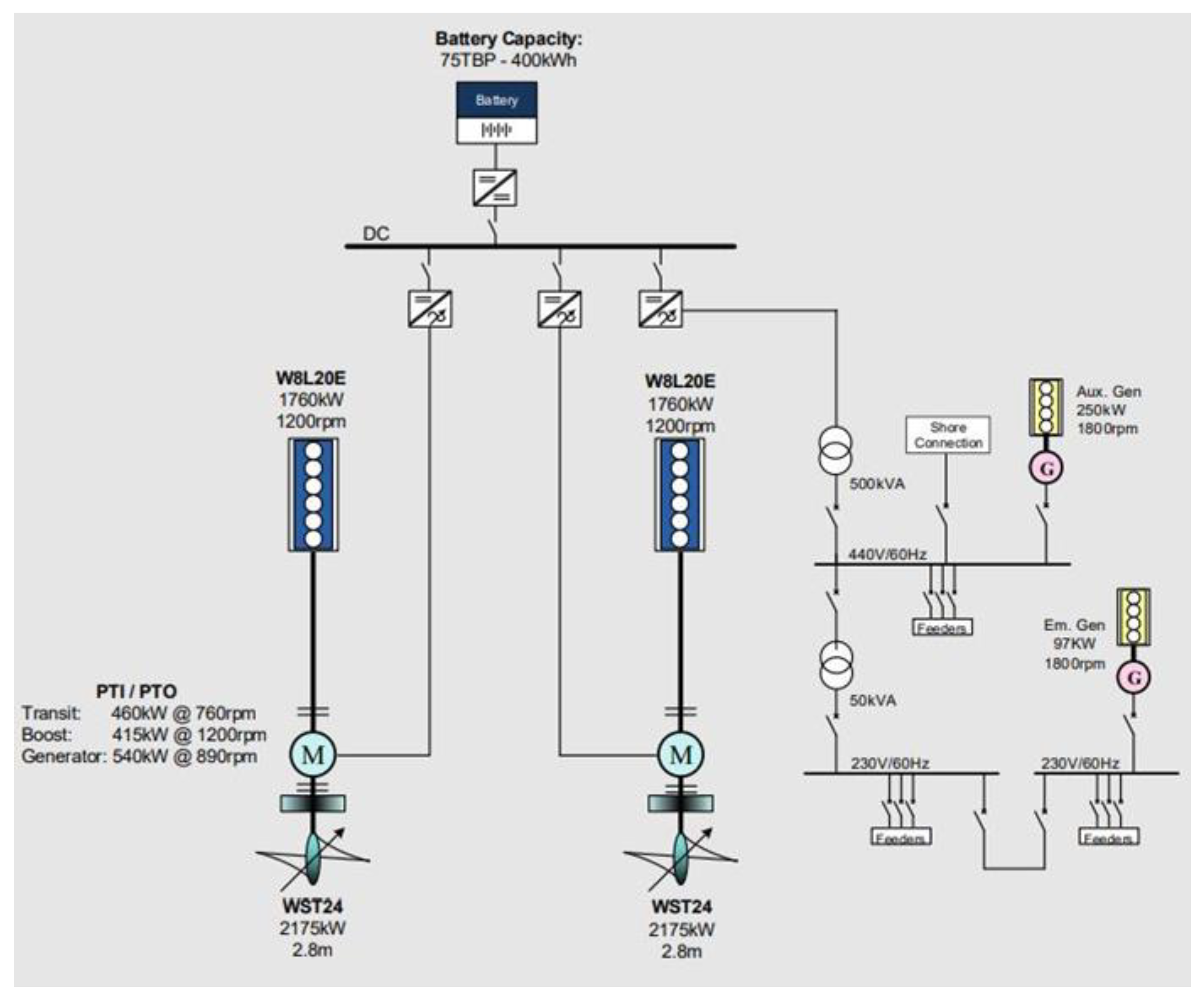
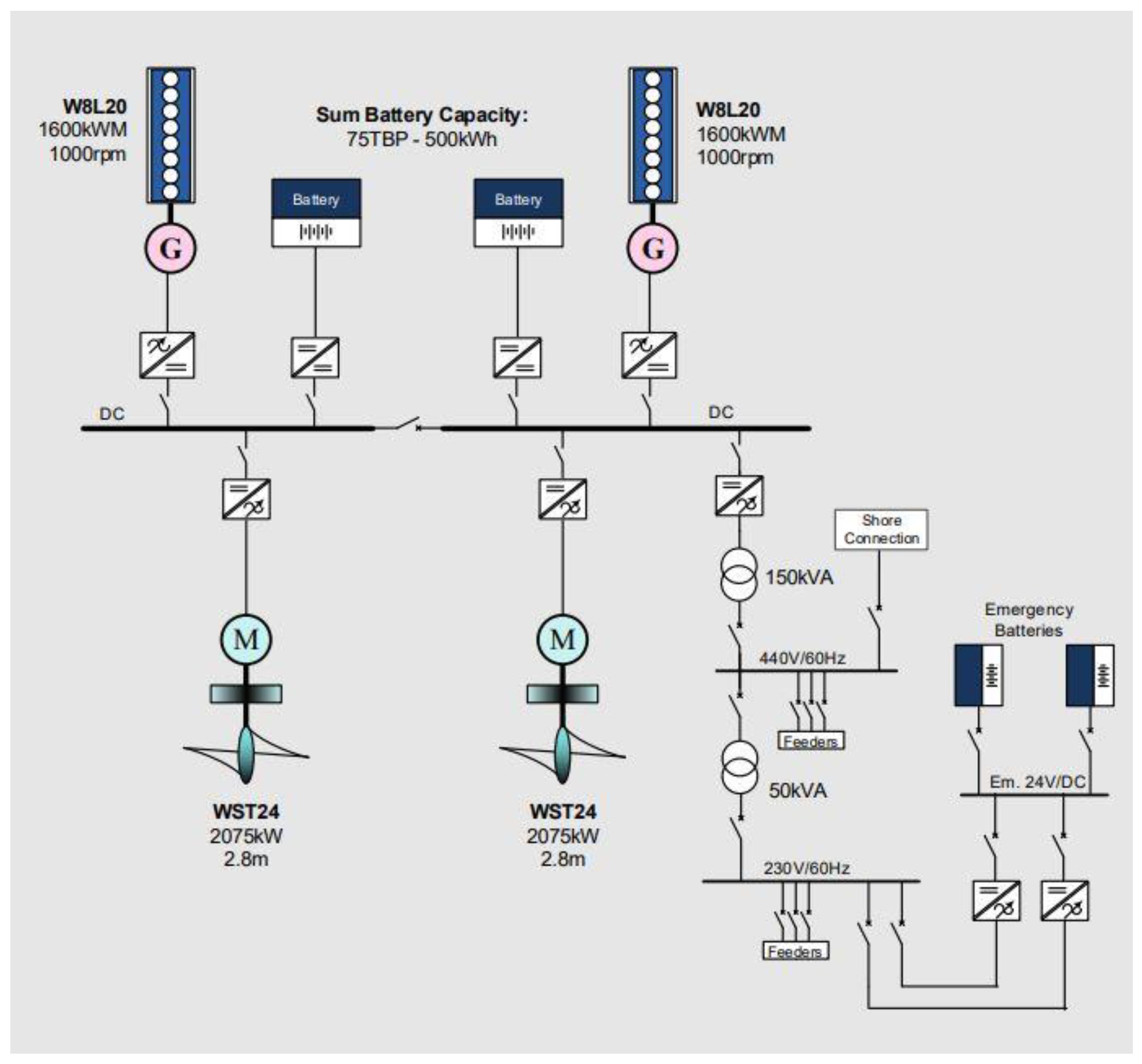


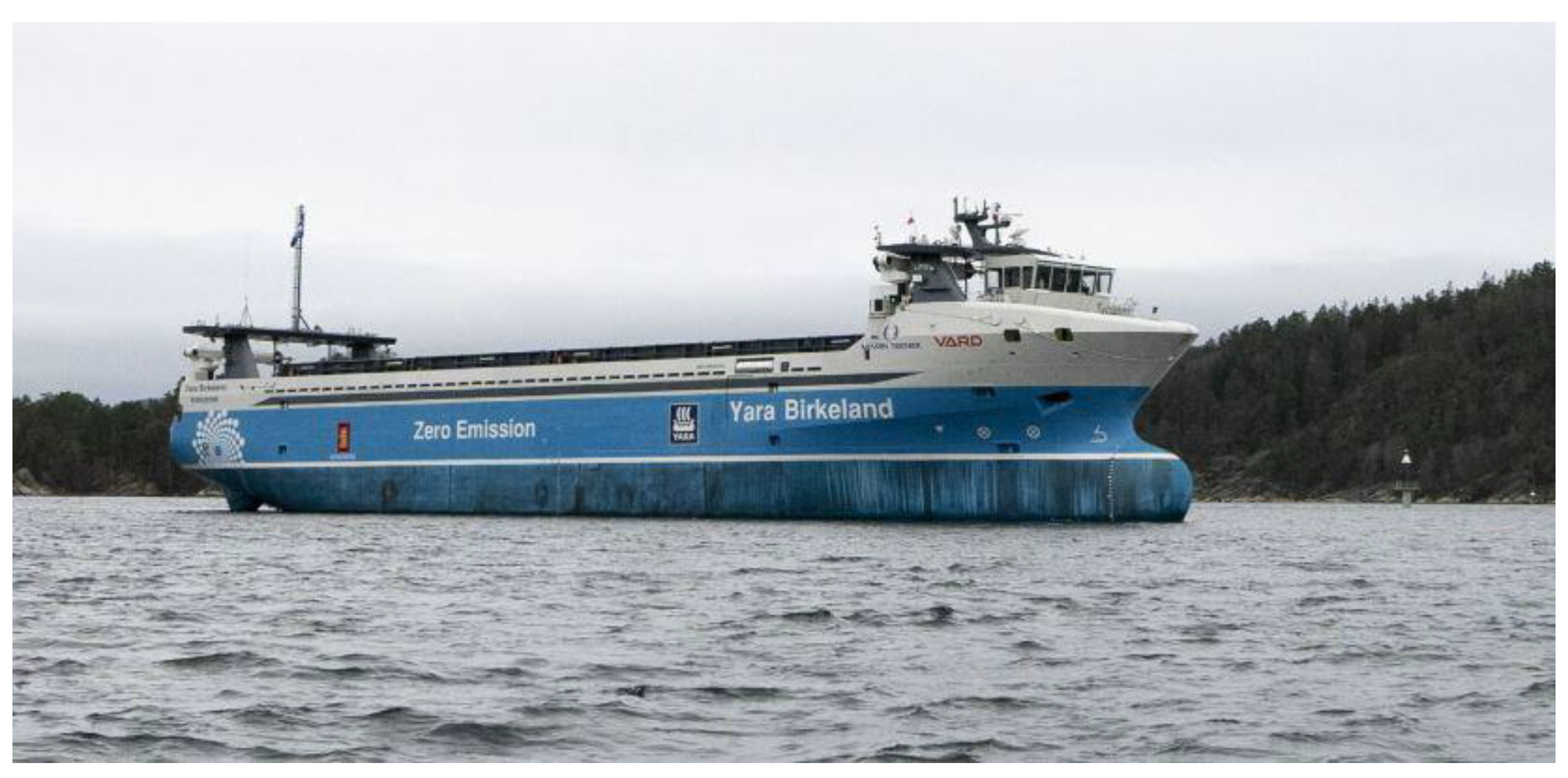
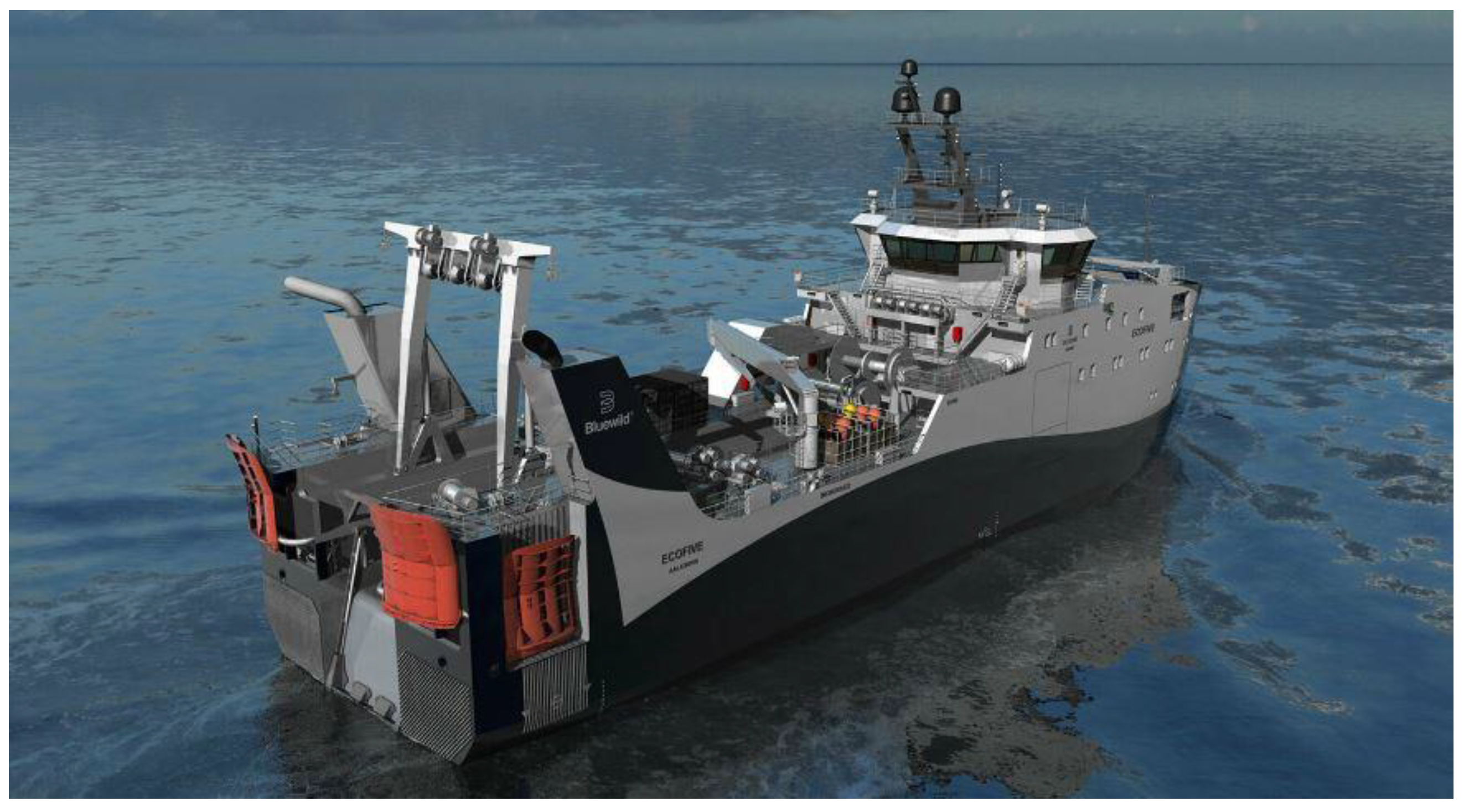
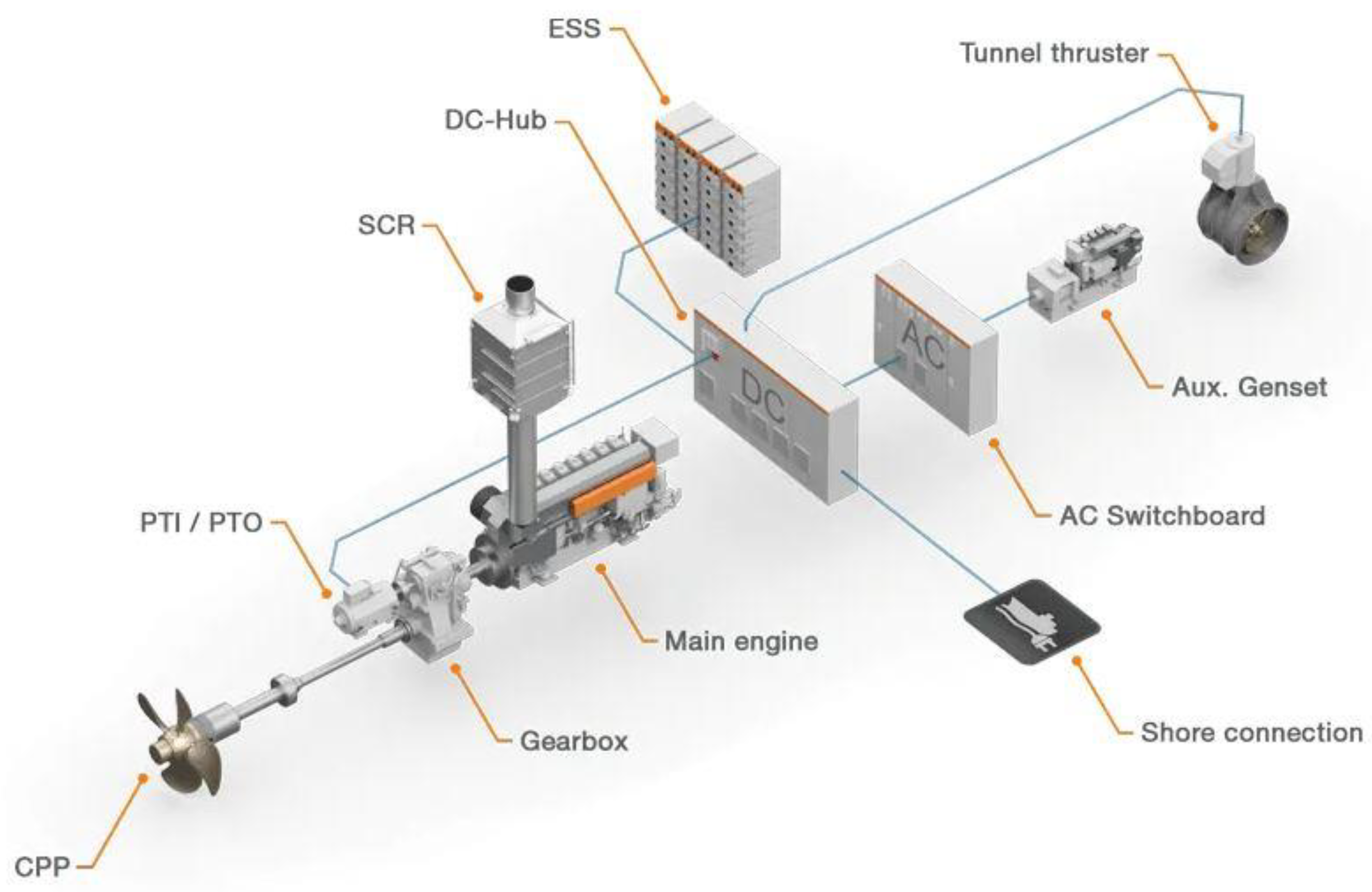
Disclaimer/Publisher’s Note: The statements, opinions and data contained in all publications are solely those of the individual author(s) and contributor(s) and not of MDPI and/or the editor(s). MDPI and/or the editor(s) disclaim responsibility for any injury to people or property resulting from any ideas, methods, instructions or products referred to in the content. |
© 2023 by the authors. Licensee MDPI, Basel, Switzerland. This article is an open access article distributed under the terms and conditions of the Creative Commons Attribution (CC BY) license (https://creativecommons.org/licenses/by/4.0/).
Share and Cite
Kolodziejski, M.; Michalska-Pozoga, I. Battery Energy Storage Systems in Ships’ Hybrid/Electric Propulsion Systems. Energies 2023, 16, 1122. https://doi.org/10.3390/en16031122
Kolodziejski M, Michalska-Pozoga I. Battery Energy Storage Systems in Ships’ Hybrid/Electric Propulsion Systems. Energies. 2023; 16(3):1122. https://doi.org/10.3390/en16031122
Chicago/Turabian StyleKolodziejski, Marcin, and Iwona Michalska-Pozoga. 2023. "Battery Energy Storage Systems in Ships’ Hybrid/Electric Propulsion Systems" Energies 16, no. 3: 1122. https://doi.org/10.3390/en16031122
APA StyleKolodziejski, M., & Michalska-Pozoga, I. (2023). Battery Energy Storage Systems in Ships’ Hybrid/Electric Propulsion Systems. Energies, 16(3), 1122. https://doi.org/10.3390/en16031122







